
How to Configure the Magento 2 Product Questions Extension
Looking to transform your website's customer interaction? Magento 2 product questions extension allows users to ask and answer queries directly on product pages.
In this tutorial, we will explain the steps to configure the Magento 2 FAQ extension.
Key Takeaways
- Set up a product FAQ section in Magento 2 quickly.
- Amplify customer engagement with on-page question forms.
- Manage and moderate ecommerce product questions efficiently.
- Improve SEO with question-based content and sitemaps.
- Customize the Q&A feature to match your store's needs.
What is the Magento 2 Product Questions Extension?
The Magento 2 Product Questions Extension is a feature-rich tool. It allows users to ask and answer queries directly on product pages. Here are some key points about this extension:
-
FAQ Section: It creates a dedicated FAQ section for products. It provides instant answers to common queries.
-
Question Management: Store admins can moderate questions and answers. They can approve or reject them as needed.
-
SEO Benefits: It generates SEO-friendly URLs for each question and answer. It improves search engine visibility.
-
Customization: It allows for customization of the question form and display of Q&A on product pages.
Key Features of Magento 2 Product Questions Extension
1. Question submission
-
The submission process is designed to be simple and user-friendly. Usually, there's a clearly visible "Ask a Question" button or link near the product description. Clicking this opens a form for related products directly on the page. The form often includes
- fields for the question
- customer's name
- email address
-
Some advanced extensions may offer additional options. For instance, customers might be able to upload Magento images to clarify their questions. They may also have the choice to make their question private or public. Private questions are only visible to the store staff, while public ones can be seen by other customers once answered.
-
The submission feature often includes validation to ensure quality. It may check for minimum length requirements or filter out common spam words. Some systems also implement a moderation queue. It allows store owners to review questions before they're published.
-
For logged-in customers, the process can be even smoother. Their information is often pre-filled in the form. It reduces friction and encourages more questions. It also helps store owners track customer engagement over time.
2. Answer management
- The management interface is typically accessible from the Magento admin panel. It often presents questions in a list format, sortable by various criteria. Admins can usually filter questions by product, date, or status (answered, unanswered, or pending moderation). This organization helps prioritize urgent queries and manage high volumes of questions effectively.
- Admins can approve, edit, or reject submitted questions. It helps maintain the quality and relevance of the Q&A section. It also allows for the removal of inappropriate content or spam before it becomes publicly visible.
- Multiple staff members can be assigned different roles or permissions. It allows for specialized handling of specific product categories or types of questions. Some systems also include internal notes or tags, facilitating communication between team members on particular inquiries.
3. Email notifications
- For administrators, Magento email notifications act as alerts for new question submissions. These emails typically include essential information. They often contain the product name, question content, and customer details. Some systems provide direct links to the admin panel for quick access. It allows for swift responses to customer inquiries.
- Some stores prefer instant alerts for each question. Others might opt for daily or weekly digests. This flexibility helps manage notification volume based on store size and question frequency.
- When an answer is provided, customers receive another email notification. This alert typically includes the whole question-and-answer text. It may also contain a link back to the product page. It encourages customers to revisit the store, potentially leading to a purchase.
4. Voting System
- The voting mechanism is typically straightforward and intuitive. Users can upvote or downvote with a single click. This ease of use encourages participation. Many systems use familiar icons like thumbs up/down or arrow buttons for voting.
- Votes help prioritize the most helpful content. Questions and answers with high vote counts often appear at the top of the list. This sorting ensures that the most valuable information is easily accessible to other customers.
- The voting system serves as a form of Magento community moderation. It allows customers to highlight good questions and helpful answers collectively. Conversely, it can push less valuable or unclear content lower in the display order.
- For potential buyers, the vote count serves as a quick indicator of relevance. A highly upvoted question likely addresses a common concern. Its answer may contain important information for making a purchase decision.
Steps to Configure the Magento Product Questions Extension
Step 1: Configure Question & Answer Settings
- Log in to the Magento Admin panel after installing the extension.
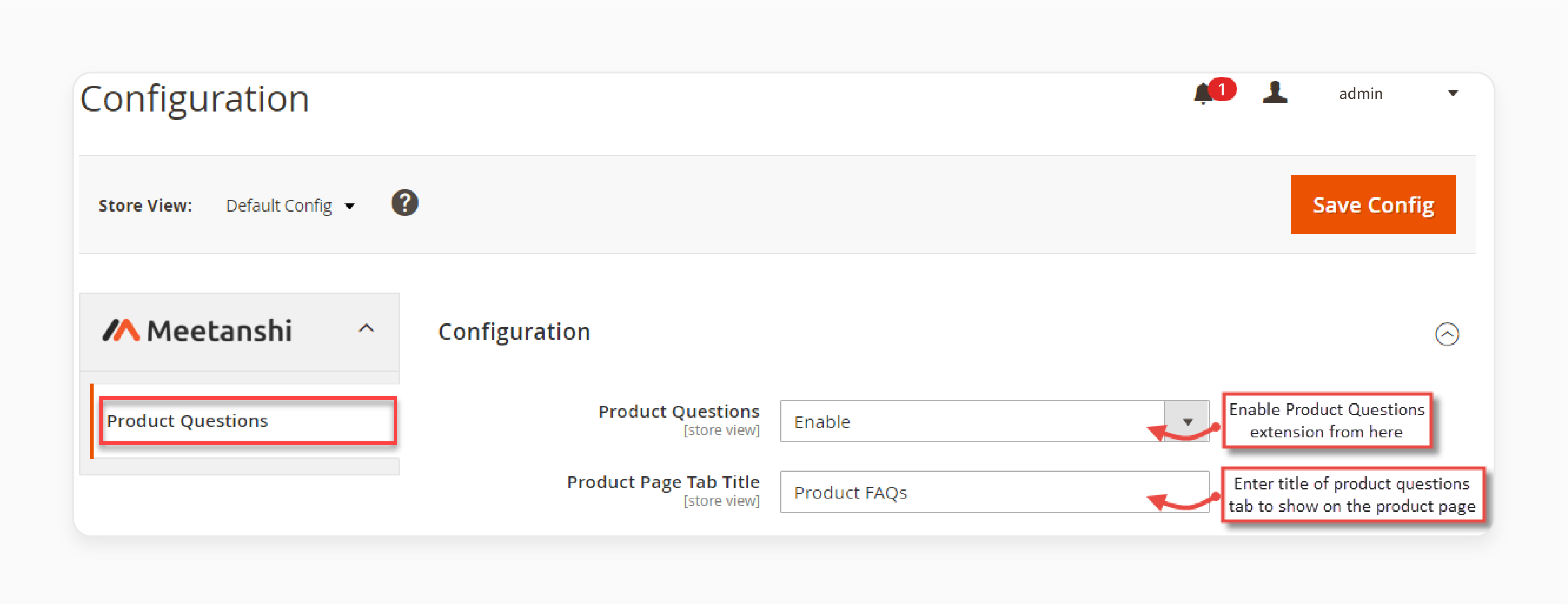
- Enable the extension and enter a suitable title.
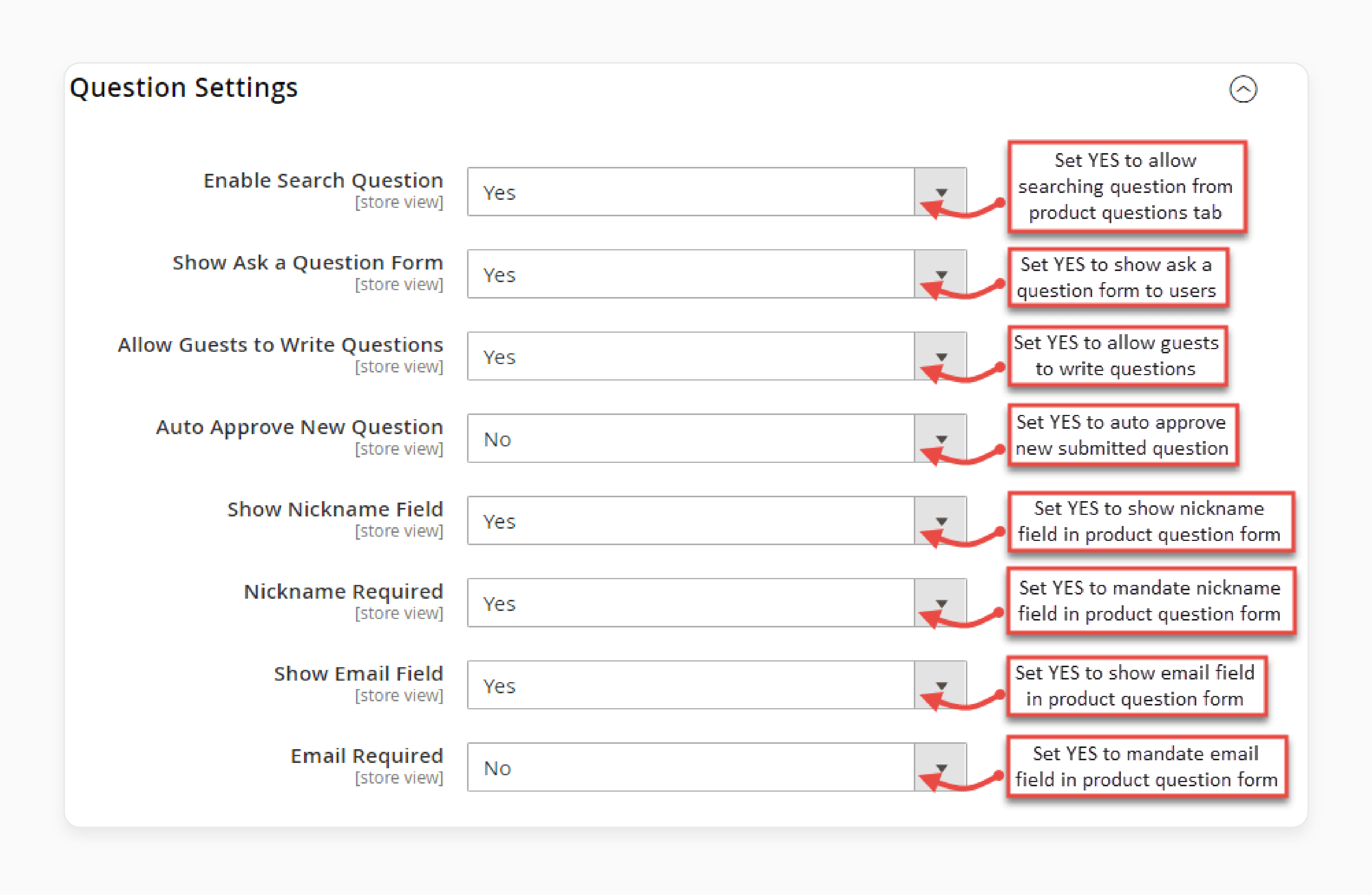
- Under Question settings, Enable Search Questions.
- Select Yes to Auto approve new questions.
- Select Yes to allow guests to write questions.
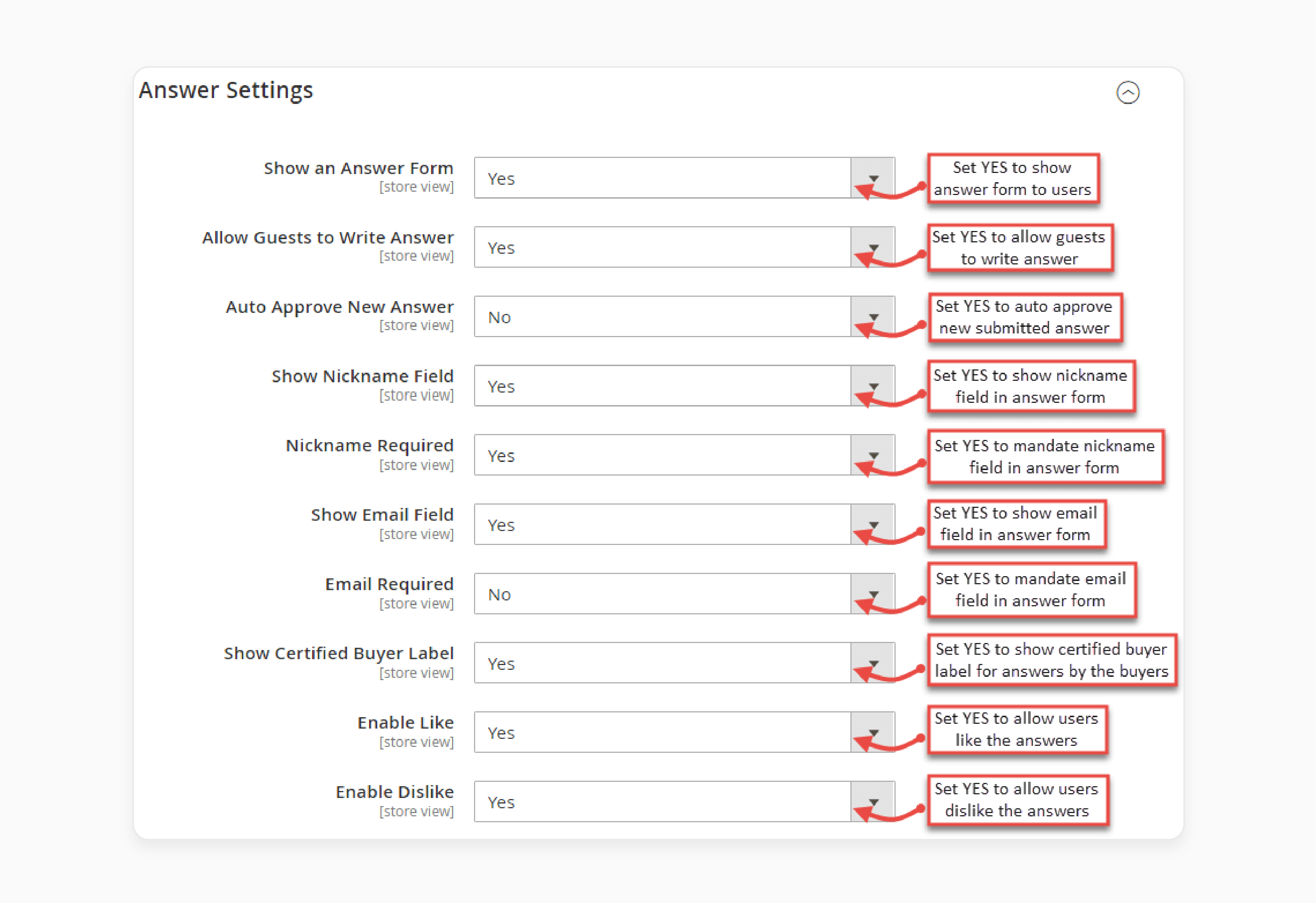
- Expand the Answer Settings and select Yes to show an answer form.
- Select Yes to show the Email Field and enable Likes.
Step 2: Question & Answer Email Settings
- Go to the Question Email Notification Settings.
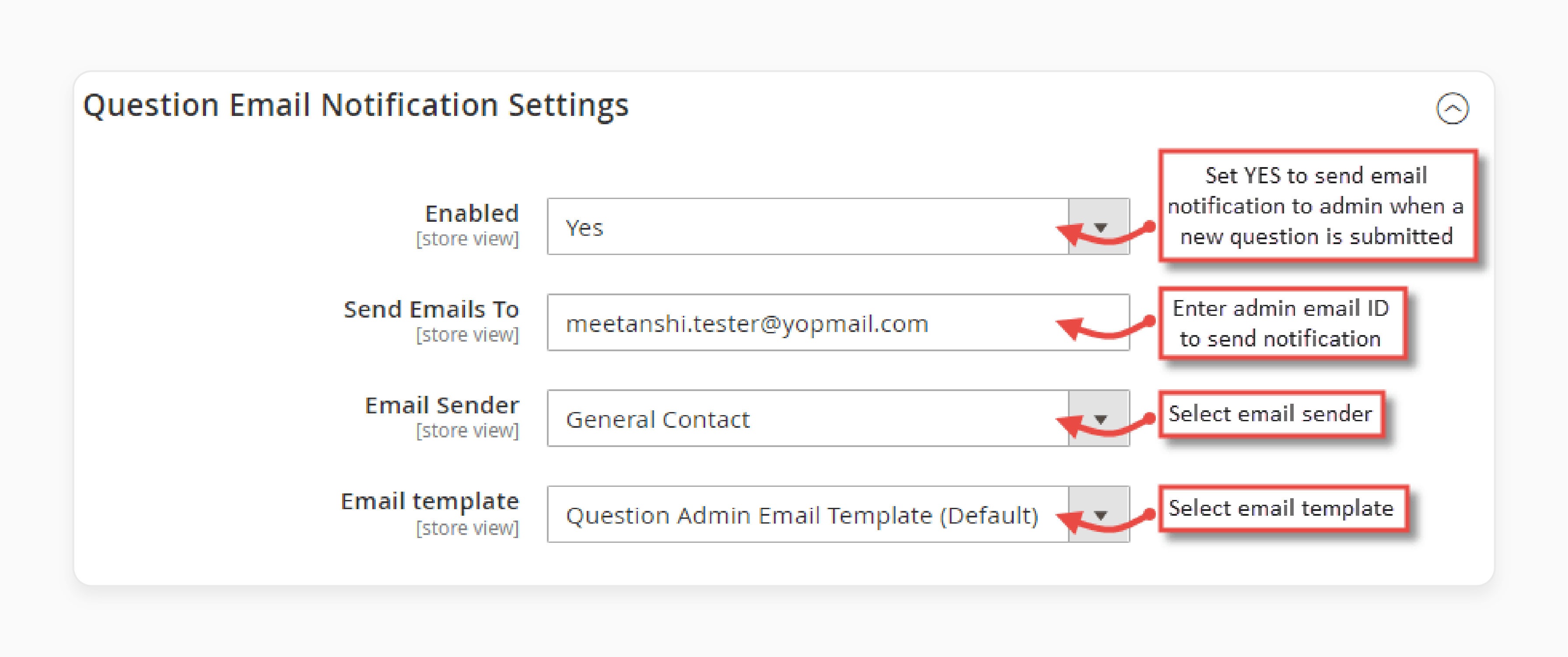
- Enter an email ID in the Send Emails To option.
- Select an Email Template from the dropdown menu.
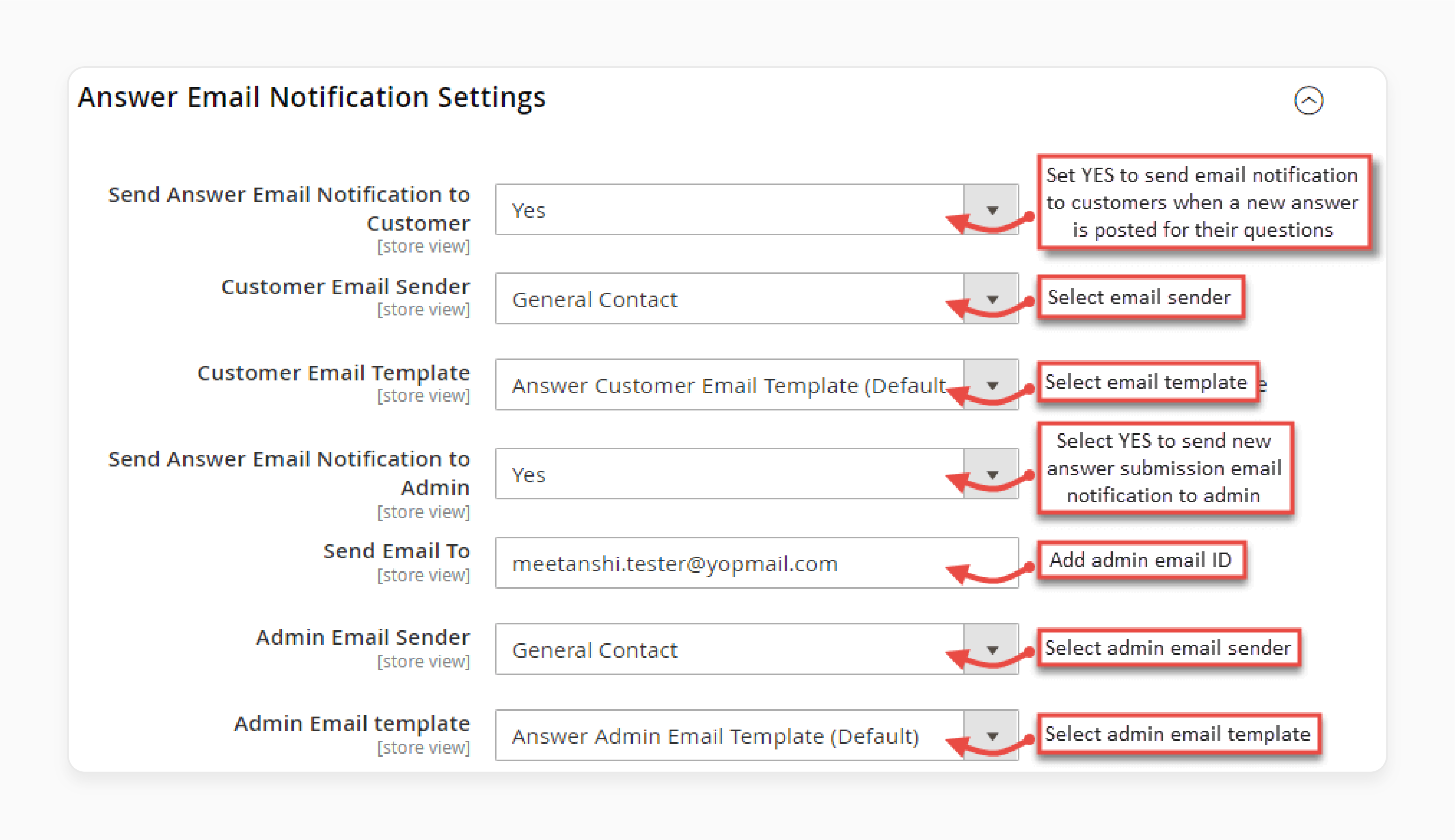
- Open the Answer Email Notification Settings.
- Choose a Customer Email Template.
- Enter your Admin email ID near Send Email to.
- Set Customer Email Sender as General Contact.
Step 3: Manage Product Questions & Answers
- Navigate to Marketing > Product Questions > Manage Product Questions.
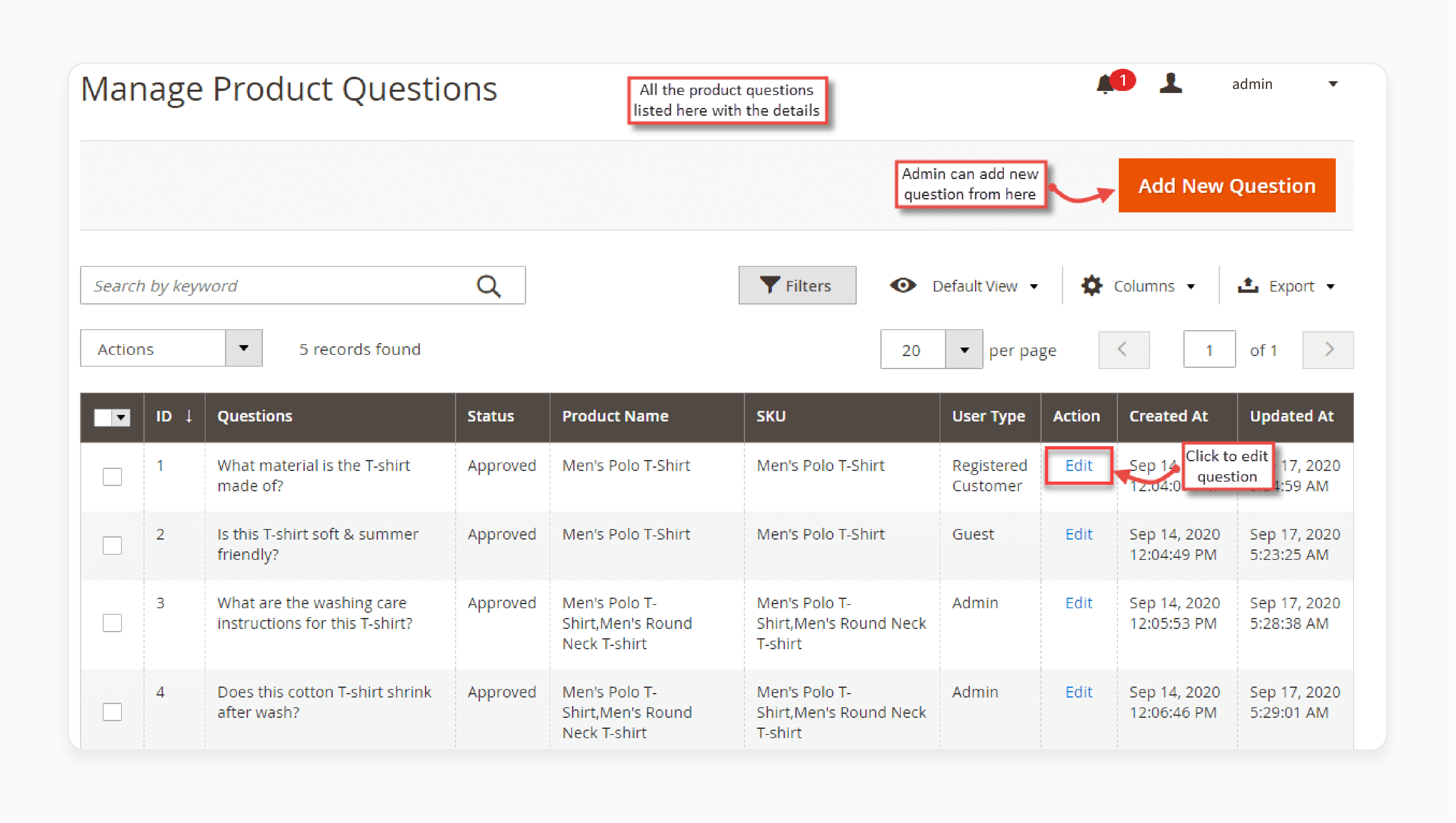
- Click on Add new question to create a new one.
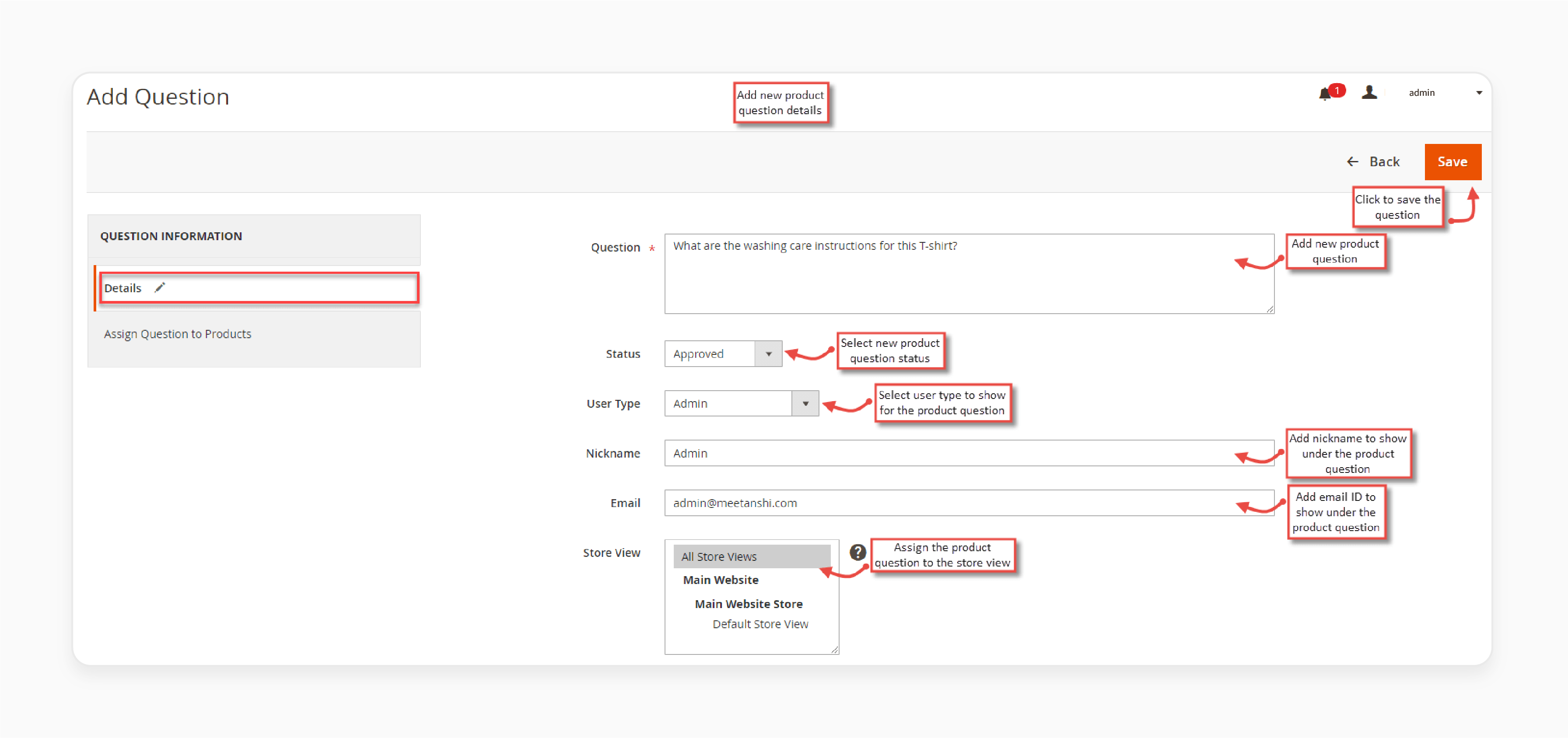
- Enter the question in the field.
- Select Approve under Status.
- Enter a support Email ID to show under the question.
- Select the appropriate Store views.
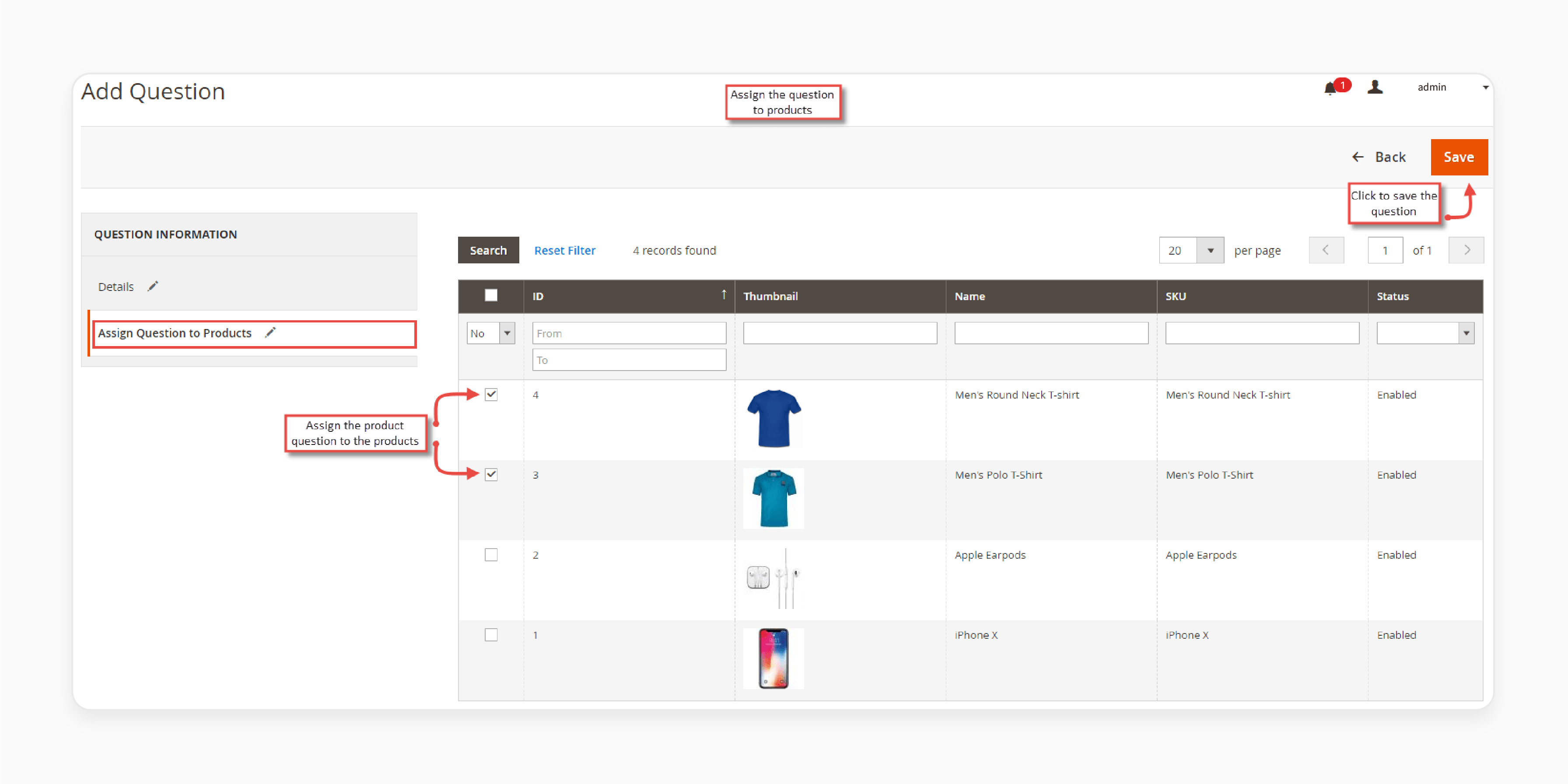
- Assign the question to the products in the menu and click Save.
- Go to Marketing > Product Answers > Manage product answers.
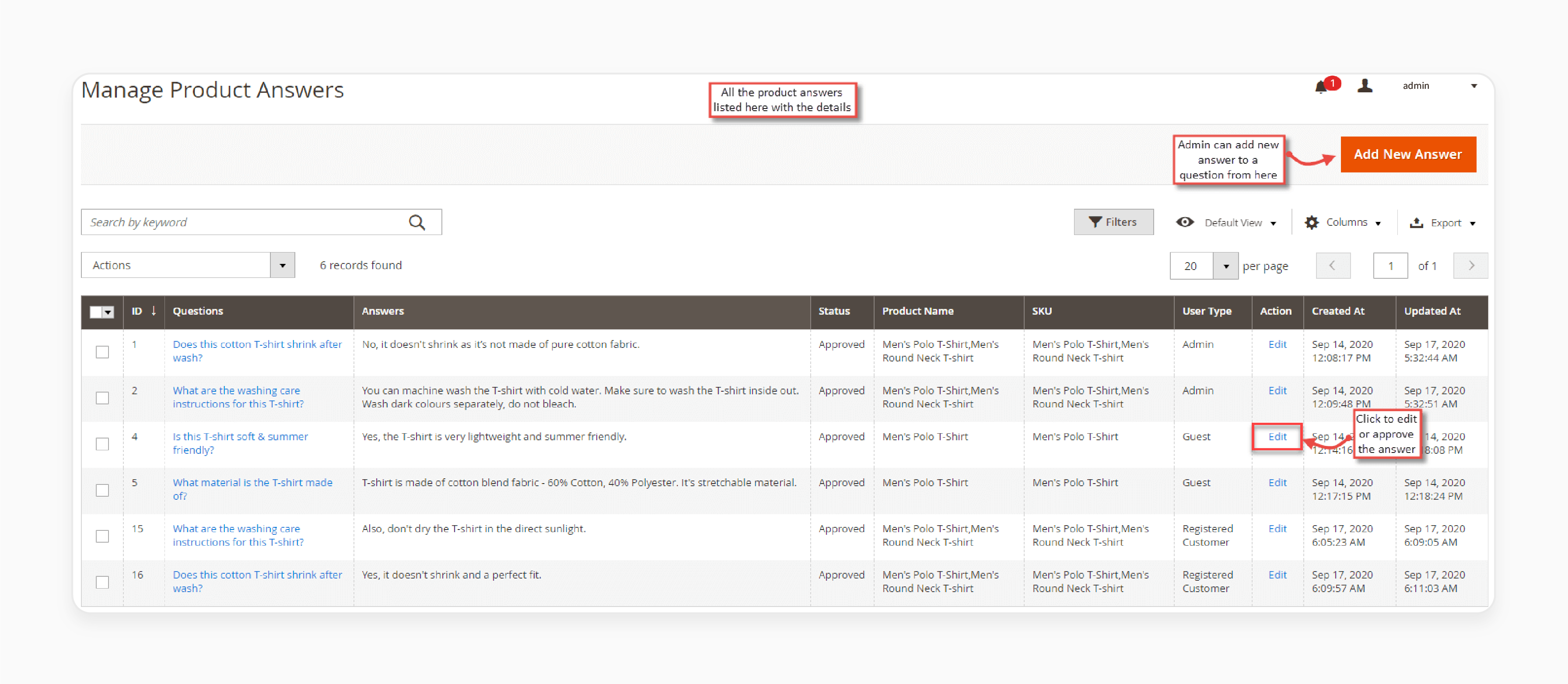

- Click on Add new answer and select a question.
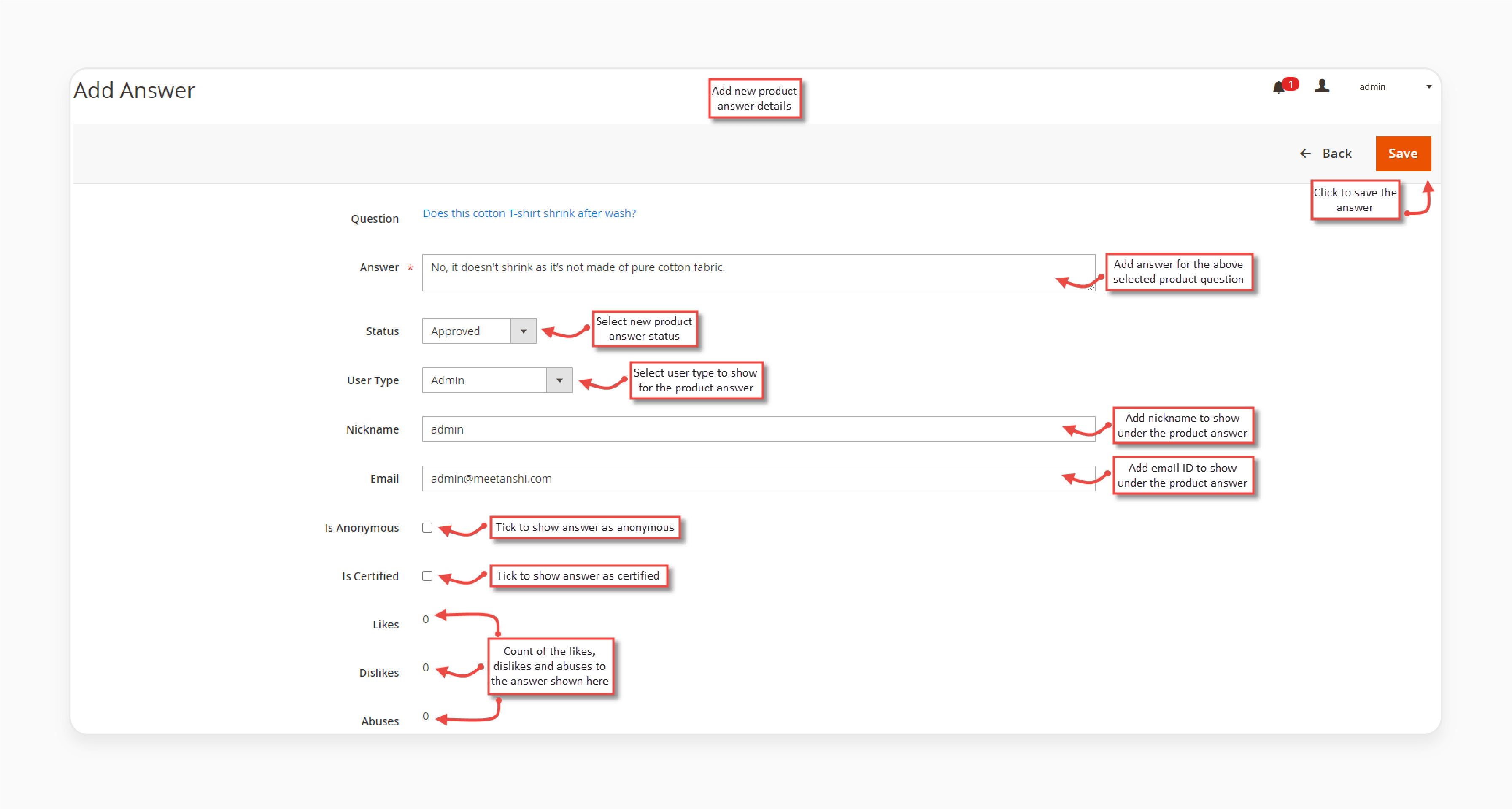
- Enter the answer using the admin email ID.
- Select User Type as Admin and click Save.
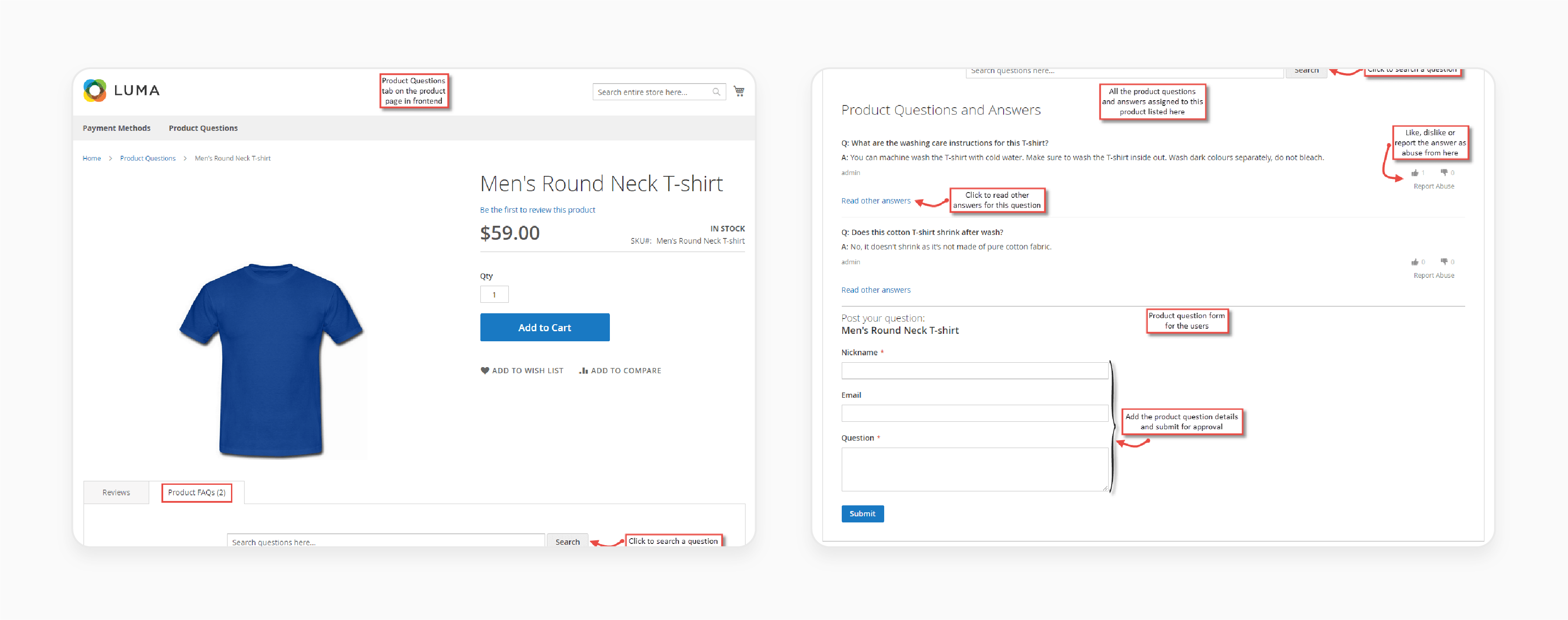
- View the product questions on the product page.
Top 3 Magento 2 Product Question Extensions
| Extension Name | Key Features | Price |
|---|---|---|
| AheadWorks Product Questions | - SEO-friendly URLs - Question moderation - Email notifications for new questions - Customizable question form and display options |
$195 (Open Source), $390 (Commerce Edition) |
| Mageplaza Product Questions | - Knowledge Base search box - Customizable URLs and meta tags - Question rating system - Social sharing options |
Starts at $149 |
| MageAnts Product Questions and Answers | - WYSIWYG editor for admin replies - Private questions option - Email notifications for new questions - Customer question rating |
Starts at $79 |
Common Challenges Faced with Product Questions in Magento 2
| Challenge | Description |
|---|---|
| Duplicate Content | Displaying identical Magento FAQs across multiple pages can lead to SEO issues. |
| Moderation Overhead | The high volume of queries can overwhelm support teams, requiring efficient moderation workflows. |
| Extension Conflicts | Product question extensions can conflict with other extensions or Magento's core functionality. |
| Customization Complexity | Customizing the extension to match specific store designs and needs can be challenging. |
| Performance Issues | Heavy use of JavaScript and database queries can slow down page loading times. |
| Security Concerns | Ensuring the privacy and security of customer data in product questions is essential. |
| Integration Issues | Integrating product questions with other extensions like review systems or Magento live chat can be problematic. |
| User Engagement | Encouraging customers to participate in asking and answering questions can be difficult. |
| SEO Optimization | Ensuring that product questions are optimized for search engines to improve visibility. |
| Technical Issues | Technical issues such as cron job failures or memory limits can affect the extension's functionality. |
Best Practices for Product Questions in Magento 2
1. Moderate Questions
- Moderation typically begins with a review queue in the product questions tab. New questions are held in this queue before being published. It allows admins to assess each question carefully. They can check for relevance, appropriateness, and potential duplicate inquiries.
- The ability to edit questions is a key aspect of moderation. Sometimes, Magento customers may ask questions but use unclear language. Admins can refine the wording to make it more understandable. It improves the overall quality of the Q&A section.
- Auto-moderation tools can be valuable for initial filtering. These might use keyword detection to flag potentially problematic content. However, human review is still essential for nuanced decisions.
2. Customize Question Forms
- Restricting questions to registered users can reduce spam and encourage account creation. It also provides more context about the inquirer. It potentially leads to more personalized responses. However, this approach may limit the number of questions received.
- Allowing all visitors to ask questions can increase engagement and provide valuable insights from a broader audience. This approach is beneficial for stores aiming to build a comprehensive knowledge base quickly. It can also help capture questions from potential customers who aren't ready to create an account yet.
- Consider adding a Magento dropdown menu for question categories. It can help route questions to the appropriate department or expert. Categories might include "Product Specifications," "Shipping," "Compatibility," etc.
- For admin replies, integrating a WYSIWYG editor is highly beneficial. This rich text editor allows staff to format their answers with bold text, italics, bullet points, and even images. Such formatting can make complex answers more readable and understandable.
3. SEO Optimization
- This practice involves generating SEO-friendly URLs and meta tags for each Q&A entry. These URLs should be descriptive and include relevant meta keywords. For example, use something like "
domain.com/product-name/questions/how-to-install." This structure helps search engines understand the content of the page. - Optimize the content of questions and answers for relevant keywords. Encourage customers to use product names or specific features in their questions. Ensure that staff answers are comprehensive and naturally incorporate essential keywords.
- Link relevant questions and answers to appropriate product pages and vice versa. It helps Magento search engines understand the relationship between your content and can improve overall site SEO.
- Consider creating a Magento sitemap that includes your Q&A pages. Submit this sitemap to search engines to ensure they can quickly discover and index all your Q&A content.
4. Customize Email Notifications
- For store admins, email notifications act as alerts for new question submissions. These emails typically contain essential information about the inquiry. They often include the product name, question, and the customer's details. Some systems provide direct links to the admin panel within the email. It allows for quick access and swift responses to customer inquiries.
- Some stores offer instant alerts for new questions. Others might opt for daily or weekly digests. This flexibility helps manage email settings based on the store's size and the frequency of questions.
- On the customer side, email notifications serve multiple purposes. First, they confirm that a question has been received successfully. This acknowledgment reassures customers that their inquiry is in the system. It often includes an estimated response time, which helps set clear expectations.
- Some systems offer escalation notifications. If a question remains unanswered for a set period, higher-level administrators might be alerted. It helps prevent questions from falling through the cracks and ensures timely responses.
FAQs
1. How does the Magento 2 FAQ and Product Questions Extension improve customer engagement?
This extension allows customers to ask questions directly on the product page. It enables them to find answers to their queries quickly. It creates a dedicated FAQ section for products. It lets visitors ask public or private questions about the product. It helps customers understand the product better before making a purchase decision.
2. Can store administrators manage questions from the backend in Magento 2?
Yes, the extension provides a questions grid in the backend. It is where admins can manage questions and their answers. They can add questions, rate questions, and decide which questions to display. Admins can also move questions between products and assign questions to multiple products. It helps to address repetitive questions efficiently.
3. How does the voting system work in the Product Questions Extension for Magento 2?
The voting system allows customers to rate answers based on helpfulness. This feature helps prioritize the most valuable content. It consists of highly rated questions and answers appearing at the top of the list. It serves as a form of community moderation. It ensures that the most relevant information is easily accessible to other customers.
4. Can the Product Questions Extension be customized to match the design of my Magento 2 store?
Yes, the extension offers various Magento customization options. You can customize the question form, display options for Q&A on product pages, and even the email notification templates. However, it's worth noting that extensive customization may require technical expertise to ensure it matches your store's specific design and needs.
5. How does the Product Questions Extension for Magento 2 help with SEO?
The extension generates SEO-friendly URLs and meta tags for each question and answer, improving search engine visibility. It also allows you to optimize the content of questions and answers with relevant keywords. Additionally, you can include Q&A pages in your XML sitemap, helping search engines discover and index all your Q&A content more efficiently.
Summary
The Magento 2 product questions extension is a helpful tool that informs customers more about the product or service usage. In this tutorial, we explained how to configure the extension. Here is a quick summary:
- Magento 2 FAQ and Product Questions extension enhances customer engagement.
- Customers can ask questions directly on front-end product pages.
- Admins manage and answer questions from the Magento 2 backend.
- Extension offers SEO benefits with structured data and sitemaps.
- Customizable features include question forms, categories, and email notifications.
Combine managed Magento hosting services with product question tools for valuable insights and better growth.





